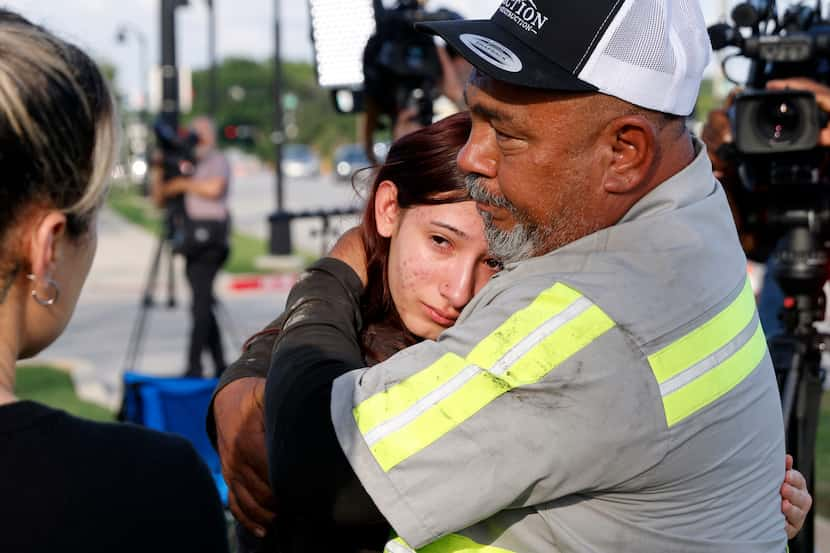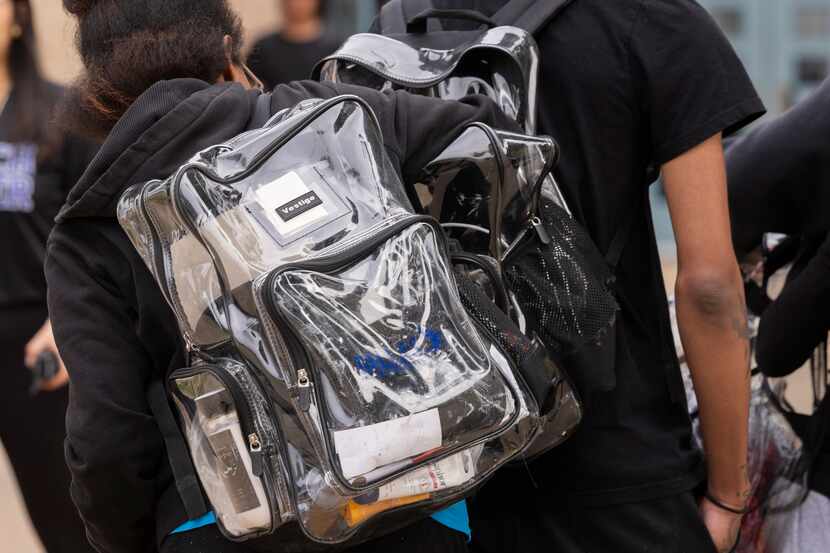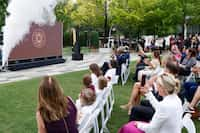
6:00 AM on Apr 27, 2024 CDT — Updated at 2:32 PM on Apr 27, 2024 CDT
In the past two weeks, gunfire has rocked three North Texas school communities.
None of the incidents devolved into the kind of mass shooting the nation has come to know too well. But they shook students’ sense of security and ignited questions about what more leaders can do to keep children safe.
“It’s a paralyzing fear,” said Dallas mother Danielle Curtis, whose daughter was at Wilmer-Hutchins High when one student shot another in a classroom on April 12.
Texas leaders took steps intended to make schools safer after a gunman killed 10 people at Santa Fe High School in 2018. They did so again after a gunman killed 19 children and two teachers at Robb Elementary in Uvalde.
Receive our in-depth coverage of education issues and stories that affect North Texans.
Even with the raft of new security mandates, violence continues to hit campuses and schools are struggling in their role as a battleground in society’s intractable fights. North Texas — like so many communities — contends with a proliferation of guns, retaliation between gangs and a shortage of mental health resources.
“You can’t separate our schools from our community,” Dallas ISD school board president Justin Henry said.
A national nonprofit has tracked at least 63 incidents of gunfire on school grounds this year. That’s on top of the more than 500 incidents reported over the previous three years. The shootings that don’t make national news, that don’t leave their cities’ names synonymous with tragedy, still leave deep scars.
On Wednesday, 18-year-old Etavion Barnes was killed outside James Bowie High School in Arlington after another student shot him multiple times. Less than two weeks earlier, a student was shot and wounded inside a classroom at Wilmer-Hutchins High School in southeast Oak Cliff.
“We have to stop pretending like gun violence in schools is normal,” Judith Juarez, a Dallas ISD graduate, told the school board Thursday night.

Around the same time Juarez spoke, news of another shooting near a DISD campus began to trickle out.
A Roosevelt High School employee was driving a pair of football players home when the two students were wounded in a drive-by shooting off campus. It was after school hours, but in a rush to get aid, the staff member drove the students back to Roosevelt.
The district canceled classes Friday at that campus because of information it received about security threats. Officials are discussing how to safely reopen.
Meanwhile, officials in both DISD and the nearby Garland school district announced stepped up security protocols as a result of the recent shootings. Garland students will see daily random searches using walk-through metal detectors, checks of exterior doors, increased faculty duty stations and more safety lessons in classes that include conflict resolution, officials said in a statement to the community.
Craig Miller, a former Dallas ISD and city police leader, drew a distinction between the recent violence in North Texas and mass casualty events at Robb Elementary, Parkland and Sandy Hook.
He said it appears the local shootings were targeted. Details have not been made public, but Miller speculated the shootings could involve personal beefs between students.
“We don’t know the answer,” Miller said. “Those are issues that are deep-rooted and emotional issues that take place in students’ lives outside of campus that just happen to spill onto the campuses.”
Changes after Uvalde
David Riedman — a researcher who created the K-12 School Shooting Database tracking gun violence on campuses — said the recent incidents demonstrate the complexities of keeping schools safe and how unrealistic it can be to completely secure buildings.
“A school is a place where people are in and out of the building the entire day,” he said. “So you can fortify the main school building. You could add ballistic windows … but the reality is that it’s not a supermax prison.”
Much of Texas lawmakers’ action on school safety has centered on how to “harden” campuses. They have largely not touched the state’s gun laws.
Uvalde parents continue to pressure the Legislature to raise the minimum age to purchase certain semi-automatic rifles from 18 to 21.
Gov. Greg Abbott has said such a law would be unconstitutional.
Lawmakers instead mandated every public school in Texas have at least one armed staffer on campus and added some money to school safety allocations.
Miller cautioned that stationing police on campus isn’t enough. School resource officers must develop trust with students so teenagers feel comfortable bringing in tips.
“If there is a beef going on outside of the campus, you want kids to have a relationship with that law enforcement officer,” Miller said. “That information is so critical. … We’ve got to have kids that come forward and tell us what’s going on, so that we can help them.”
It’s been difficult for districts to comply with the armed guard mandate because of a lack of funding and manpower, administrators said. The Legislature did not provide nearly the level of funding that school leaders said they need for safety measures.
“If lawmakers think they checked a box on school safety last session, we should be appalled at how low the bar is,” Texas AFT spokeswoman Nicole Hill said. “They tossed 28 extra cents per student into school safety funding and then mandated underfunded districts hire armed security guards on every campus — an expense not even close to covered by those extra pennies.”
Lawmakers also required that schools install a silent panic button in all classrooms, which would immediately alert law enforcement to emergencies.
Certain district employees must go through mental health training to help them recognize and support students experiencing a crisis that could threaten school safety.
Meanwhile, North Texas districts are doing more to fortify facilities on their own.
They are paying for bullet-resistant window film or building secure vestibules that visitors are supposed to go through when they enter campus. A handful of area districts, including Cedar Hill, have bond elections on the May 4 ballot to fund such efforts.
Many districts — including Dallas — employ metal detectors in their middle and high schools. DISD students use clear backpacks as a precaution.
In a late Friday statement about Wilmer-Hutchins, DISD officials said their investigation showed “the handgun was brought into the school during the late entry process during which several safety protocols were not strictly followed.” The district did not provide specifics.
What happened in Dallas and Arlington?
The investigations into what happened during each of the recent events are ongoing.
At Bowie, police received reports of shots fired near a portable building on campus a little before 3 p.m., according to police. School resource officers found Etavion Barnes lying unresponsive on the ground. Officers attempted “life-saving measures” until paramedics arrived, officials said.
Barnes was shot “up to five or six” times, Arlington police Chief Al Jones said during a news conference. He was taken to a local hospital, where he was pronounced dead, Jones said.
Authorities were working to determine a motive, but police believe a 17-year-old targeted Barnes. Both teens were students, police said.
The Wilmer-Hutchins shooting took place inside a classroom. The victim was struck in the upper thigh, an injury police said was not life-threatening.
The following Monday, students walked out in protest, saying they did not feel safe on campus and wanted school leaders to do more to protect them.

Multiple teenagers expressed frustration that the school’s metal detectors are not regularly used and the school does not consistently enforce its clear bag policies.
“We have whole metal detectors, we have wands, but now they want to finally use [them] after something bad happens,” said Yanely Gamino, a student who participated in the walkout.
The anger bled into Thursday’s DISD school board meeting. Wilmer-Hutchins parent Curtis described the terror of receiving texts from her child about a shooting.
“We need answers,” she told trustees. “What security measures have been added? Why has no one communicated with the parents? … What would your expectations be if this was your child?”
Her daughter, 16-year-old Aspen, said she wants the district to take accountability for not having sufficient security and not checking bags thoroughly.
“They should make the school a safe haven,” Aspen said.
In their Friday statement, DISD officials agreed that’s what they must work toward.
“We have implemented immediate changes districtwide including increasing personnel for arrival and dismissal, comprehensively retraining all staff on backpack searches, wands, and metal detectors, and revamping schedules so more staff is available to monitor students on the campus,” it read.
How to make schools safer?
The same question emerges every time a gun is fired on campus: How do we keep this from happening again?
Hill, with Texas AFT, said educators support a wide variety of strategies. They want enforceable safe firearm storage laws, “red flag” legislation and stronger background checks on weapon purchases.
“Fully fund mental health services and supports in Texas public schools, which are devastatingly understaffed in critical positions, including nurses, counselors, social workers, and psychologists,” she demanded.
Riedman said the solutions must stem from the community and home.
“Teenagers are getting access to weapons that they can’t legally purchase,” he said. “So that means, at some point, there was a legal gun owner who didn’t secure this weapon.”
Beyond safe gun storage, the researcher urged adults to teach teenagers more strategies for dealing with conflict resolution and to invest more in crisis intervention.
Riedman said students need to understand that when they go to settle a dispute with a gun, “you’re not only ending someone else’s life, you’re ending your own life.”
Riedman spoke to The Dallas Morning News about his ideas for reducing gun violence while at an event marking the 25th anniversary of the Columbine shooting. In the more than two decades since that tragedy, the country has invested billions in fortifying schools.
“When it hasn’t worked for 25 years, this is really an appropriate time to think about whether we need to completely change our perspective,” Riedman said.
Reporters Jamie Landers, Kelli Smith, Julia James and Lana Ferguson contributed to this article.
The DMN Education Lab deepens the coverage and conversation about urgent education issues critical to the future of North Texas.
The DMN Education Lab is a community-funded journalism initiative, with support from Bobby and Lottye Lyle, Communities Foundation of Texas, The Dallas Foundation, Dallas Regional Chamber, Deedie Rose, Garrett and Cecilia Boone, The Meadows Foundation, The Murrell Foundation, Solutions Journalism Network, Southern Methodist University, Sydney Smith Hicks and the University of Texas at Dallas. The Dallas Morning News retains full editorial control of the Education Lab’s journalism.

Talia Richman, Staff writer. Talia is a reporter for The Dallas Morning News Education Lab. A Dallas native, she attended Richardson High School and graduated from the University of Maryland. She previously covered schools and City Hall for The Baltimore Sun.
talia.richman@dallasnews.com @talirichmanDallas PD report reveals details about alleged assault in which police suspect Rashee Rice

Cuban, Mavericks won’t back down from crypto suit after celebs settle for $2.4 million

Southwest Airlines’ ‘heart and soul’ Colleen Barrett dies at 79


New Dallas women’s soccer team unveils name, logo ahead of Cotton Bowl Stadium debut
